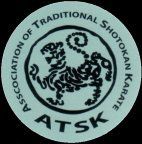Karate Info
Karate Kata

Karate Kata
"Kata, or forms, are composed of a series of moves and techniques arranged in set sequences, in which the many defensive and counter-offensive techniques of Shotokan are employed, through the range of stances against imaginary opponents. They are performed on one's own therefore, and students in a kata class performing a particular kata will practice each move as a group, but independent of one another, along the particular kata's embusen, or line(s) of movement."
Click a link below to learn more about the Kata you are interested in.
Karate Kumite
THERE IS NO FIRST ATTACK IN KARATE
karate ni sente nashi
What is Kumite?
Kumite
means "sparring".
When you see two boxers fighting in the ring, they are sparring with each other. Each tries to score a point by landing a blow to the target area of their opponent, and the winner will be the one who has the most points by the end of the match.
Of course, boxing matches also sometimes end when one of the protagonists is knocked out, or when the match is stopped by the referee because one of them has been seriously hurt. This may be because (a) some of the artistry of boxing has been lost, and become subservient to the pressures of commercialism, or (b) because the boxers aren't very good at boxing, just fighting.
The sparring that we practice in Shotokan Karate is always controlled.
This is what sets us apart from many other sports, and makes us more deadly as opponents. We recognise and understand the power that Shotokan techniques bring, and we accept a responsibility for that power. If we were to enter a contest (or even a street fight) without thinking, the damage our punches and kicks could do is frightening.
Students of Shotokan Karate must practice extreme control at all times.
There is a famous phrase which Master Funakoshi coined: "There is no first attack in Karate". Your Karate training is designed first and foremost to defend against attacks, and only counter when it is safe to do so. The Kumite
discussed on this page observes this principle. The attacker always
loses.
There are several forms of Kumite
that we practice, in particular: Kihon, and Jiyu Ippon. The next two sections take a brief look at these.
Kihon Kumite
Kihon Kumite
is the application of fully controlled, formalised attacks and defences.
There are several Kihon
sets to learn. All the sets (like basics) are derived from Shotokan Kata. As you advance in your training, with each grade you learn a new set. Each set introduces a variation of attack and defence.
For example, one of the first sets you are likely to come across, is Gohon Kumite. This is a sequence of five Jodan Oi Zuki
(upper-level stepping-punches), performed one after another, while stepping forward. Each punch is met by Age Uke
(upper-rising block), performed, while stepping backwards, to counter the attack, finishing with a counter-punch (Gyaku Zuki) after the last defence. The initial attack is carried out with the attacker in formal Zenkutsu Dachi
stance, while the defender stands in Shizentai.
Sounds easy? Next time you're in the Dojo, try it - at high-speed! Believe me, it's not as simple as it sounds.
Other sets (there are 5 main ones, in addition to the above) mix combinations of attacks, defences, and counter-attacks. For example, the Chudan
(middle-level) attack from Set 4 is a stepping punch (nice and simple). But the defence and counter-attack is a combination: Shuto Uke, Kizami-Geri, Nukite
(look up the words for yourself in the Karate Dictionary on this website). And remember, all sets are performed from both sides, left and right.
Both left-hand and right-hand attacks and defences must be learned, and 5 different attacks Jodan Zuki, Chudan Zuki, Mae Geri, Kekomi Geri, and Mawashi Geri,
are involved from Set 3 onwards.
Jiyu Ippon Kumite
Once you have learned the Kihon
sets, it's time to start learning the Jiyu Ippon
Sets (semi-free, one-attack sparring).
As with Kihon, there are 5 sets to master. The major difference between these and the Kihon
sets is that they are conducted from the Jiyu Dachi
(free standing) position. The sets begin with quite simple moves. For example, Set 1 Jodan
is an Oi Zuki
attack to the head, countered by side-stepping away from the blow, defending Shuto Uke, and countering with Chudan Zuki
(it's not really possible to describe in words - you need to be in the Dojo to see it demonstrated). Set 5, however, involves much more complex defences, including jumping-kicks, and take-downs.
Just like Kihon, both left-hand and right-hand attacks and defences must be learned, and 5 different attacks Jodan Zuki, Chudan Zuki, Mae Geri, Kekomi Geri, and Mawashi Geri,
are involved from Set 3 onwards.
As a rule, you wont start to learn Jiyu Ippon
techniques until you get your Purple & white belt (4th Kyu).
Later, certainly after you get your black-belt, you can concentrate more of your personal training to developing your Kumite
skills for full freestyle sparring.
And Beyond...
So, what's next?
Karate training is ongoing and will help with changing your weaknesses and help with your everyday life, whether you are in education or work.
With training your mind and body together and practicing to perfect your techniques with Kihon, Kumite and Kata, you will use the mental training to focus on the everyday aspect of life and how you can try and perfect everything you do.
Finally, be sure that control is your objective at all times; control of yourself first, then control of your opponent. And always remember...
THERE IS NO FIRST ATTACK IN KARATE
